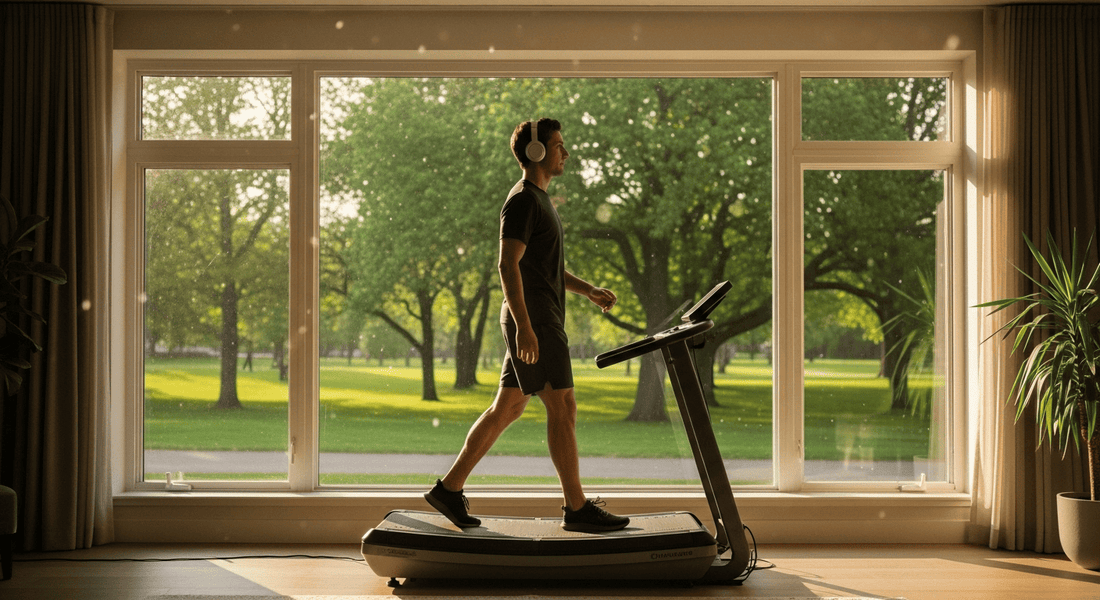Key Highlights
- Walking is a low-impact exercise that can provide substantial pain relief and improve quality of life for individuals with chronic pain.
- This form of physical activity works by boosting circulation, reducing inflammation, and releasing endorphins that act as natural painkillers.
- It's crucial to start slowly and gradually increase your walking distance and intensity to avoid exacerbating pain.
- Incorporating pain management techniques, like stretching or using heat/cold therapy, before and after walking can enhance its effectiveness.
- Always consult your doctor or a physical therapist for a personalized walking plan tailored to your specific condition and needs.
Introduction
Living with chronic pain can really affect your quality of life. Doing even easy tasks can feel hard. There isn't a single solution that works for everyone, but adding gentle activities like walking can help you manage pain and improve your well-being. In this guide, we will look at the great benefits of walking for chronic pain. We will also give you an easy plan to start safely and effectively.
Understanding Chronic Pain and Walking as Relief
Chronic pain is pain that lasts for three months or more. It can come from different causes, like injuries, diseases, or other medical issues. This pain is not just a physical feeling. It involves both body and mind, which can greatly affect everyday life.
Walking is a simple activity. However, it can help people who struggle with chronic pain. It is low-impact, so it doesn't put much pressure on the joints. This makes walking a good exercise choice for many people. Additionally, walking can help with both the body and mind concerning chronic pain.
The Science Behind Pain and Movement
Many studies show that exercise is a great way to handle chronic pain, and walking is helpful too. A review in the "Journal of Pain" said that exercising, like walking, clearly lowers pain and improves how well people with chronic musculoskeletal pain can move.
The reason for this link is how our body reacts to movement. When you walk or do physical activity, your body makes endorphins. These are natural painkillers and they work with your brain to help lessen pain.
Walking also boosts blood circulation. This helps send important nutrients and oxygen to your muscles and tissues. At the same time, it helps remove waste that causes inflammation and pain. Adding a regular walking program to your daily routine can help lower pain over time and improve your overall ability to function.
How Walking Affects the Body's Pain Response
Walking is a good aerobic exercise. It boosts your heart rate and gets blood flowing in your body. This better circulation is important for pain relief. It helps send oxygen and nutrients to your muscles and tissues. It also clears out waste products that can annoy your nerves and increase pain.
Plus, walking regularly can make the muscles around your joints stronger. This gives better support and stability. This is useful for issues like knee osteoarthritis or chronic low back pain. Stronger muscles lessen the strain on your joints. This further helps with pain and makes moving easier.
Walking also changes how your body feels and handles pain. Studies show that regular aerobic activities, like walking, can change the pain pathways in your brain. This can lead to feeling less pain and growing your pain tolerance over time.
The Benefits of Walking for Chronic Pain Sufferers
Walking offers many physical and mental benefits for people with chronic pain. On the physical side, it helps strengthen muscles, good heart health, and increase flexibility. These benefits lead to more mobility, less joint stiffness, and more endurance for daily tasks.
Mentally, walking acts as a natural way to lift your mood. It helps lower stress, anxiety, and depression, which can make pain feel worse. Just going outside and enjoying nature can boost your mood. It also gives you a sense of success, which can help with pain management.
Physical Benefits: From Increased Endurance to Flexibility
Walking has many physical benefits, especially for managing pain.
First, it helps your heart and lungs. Walking is an effective aerobic exercise. It makes your heart and lungs work better at delivering oxygen to your body.
Second, it boosts your physical function. Walking builds up the muscles that support your joints. This reduces strain on your joints and helps improve your range of motion. With more strength and flexibility, daily tasks become simpler.
Lastly, it enhances mobility. Regular walking can increase flexibility and your range of motion in joints. This makes moving easier and reduces stiffness. It is especially helpful for people with arthritis, a condition that affects movement.
Psychological Benefits: Boosting Mood and Reducing Anxiety
The benefits of walking go beyond just being good for your body. Adding walking to your daily routine can really help your mind, especially when dealing with chronic pain.
First, walking can improve your mood. It helps release endorphins, which are chemicals that make you feel happier and reduce stress. This way, you can feel better and less anxious.
Second, walking gives you a sense of control. When you have chronic pain, it can feel like you can't do much. However, taking a walk, even if it's short, lets you take charge of your pain and your life.
Finally, walking can help you sleep better. Being active regularly, like through walking, leads to improved sleep. Good sleep is important for managing pain because it helps your body heal and restore energy. Plus, the tiredness that often comes with chronic pain can be lessened by regular exercise.
Setting Realistic Goals for Walking with Chronic Pain
Starting a walking routine with chronic pain means you need to set realistic goals. This helps prevent overdoing it and facing setbacks. Remember, this is a journey, not a race. So, starting small is important for long-term success.
First, check how active you are right now. Set small goals you can reach, like walking for 5-10 minutes at an easy pace. As your body gets used to this and your pain gets better, you can slowly walk longer and move at a faster speed.
Starting Small: Short Distances and Slow Pace
When you start a walking program to help with persistent pain, it's important to take it slow and build up over time. Start with short walks at a comfortable speed, even if they are just a few minutes long. Being consistent is more important than working hard at first.
Focus on making a regular routine. Rather than doing too much quickly, aim for short walks a few times each week. As your body gets used to it and your pain gets less, you can slowly walk for longer and make your walks harder.
Remember, pain should guide you. Feeling some discomfort is normal when starting a new exercise program, but sharp or severe pain means you should stop and rest. Always pay attention to what your body is telling you and do not push through bad pain. It’s also smart to talk to a physical therapist or healthcare professional for a plan that fits your needs and limits.
Gradually Increasing Duration and Intensity
Gradually making your walks longer and more intense is important for getting the long-term benefits of walking if you have chronic pain. After your body adjusts to short walks, you can start to make them more challenging.
One good way to do this is by adding a few minutes to your walks each week. You can also try walking faster in intervals during your routine. For example, alternate between a comfortable pace and a quicker pace for specific timeframes.
The most important thing is to pay attention to your body. Adjust your walking plan if you need to. If you feel pain flare-ups, don't be afraid to rest or walk less intensely. Remember, being consistent and increasing slowly is better than pushing yourself too much too fast. Aim to make walking a regular part of your life for better pain management and overall health in the long run.
Overcoming Challenges and Barriers to Walking
Starting and keeping a walking routine can be tough, especially if you have chronic pain. Pain flare-ups, feeling unmotivated, or not knowing how to start can slow you down. But if you expect these challenges and have a plan, you can keep going.
It’s important to have a way to handle pain spikes and stay motivated, even when things are hard. Get support from friends, family, or support groups. Celebrate small wins to stay inspired. Being consistent is important, and even taking short walks can lead to big benefits over time.
Dealing with Flare-Ups and Pain Spikes
Experiencing pain or flare-ups now and then is common if you have chronic pain. This is especially true when you start a new exercise routine. The important part is to have a plan to handle these moments without losing your progress.
First, pay attention to your body. If you notice more pain during or after a walk, stop and take a break. Forcing yourself to walk when you are in strong pain can make things worse. Change your walking plan if needed. You can make your walks shorter or less intense until your pain gets better.
Also, remember that managing pain is not just about one thing. It helps to use other pain relief methods in your daily routine. Having a good "pain toolkit" can be useful. This toolkit can include things like heat therapy, gentle stretching, or relaxation techniques. This way, you can handle flare-ups better and stay focused on your walking goals.
Finding Motivation and Support
Staying motivated and getting support can really help you keep up with your walking routine, especially when you deal with chronic pain.
One great tip is to ask a friend or family member to join you on your walks. This walking buddy can help keep you accountable and cheer you on. It can also make the walks much more fun. When you share your goals and progress with someone close, you feel more supported and motivated.
You might want to look into local or online support groups for people with chronic pain. Meeting others who understand what you're going through can give you helpful tips, encouragement, and shared experiences about pain management, exercise, and feeling good overall.
Tailoring Your Walking Routine for Pain Management
Customizing your walking routine can help with pain relief and stop injuries. Think about when you walk, the ground you walk on, and how you manage your pain. You can add techniques before and after each walk.
For example, if you feel stiff in the morning, taking a short walk in the afternoon could feel better. Walking on even ground and wearing good shoes can really help your comfort. Personalizing your routine is important for a pain management plan that works over time.
Selecting the Right Terrain and Time of Day
When adding walking to your routine for pain management, think about the surface and time of day as they can affect your comfort and overall experience. For those with low back pain, walking on softer surfaces like trails or grass is often better than pavement. Softer ground absorbs shock and puts less strain on your spine.
If you have joint stiffness in the morning, try taking a walk during lunch or in the evening. Also, if you are sensitive to heat, early morning or evening walks might feel more comfortable. It's smart to check the weather and air quality to pick the best times for your walks. This way, you can get the most benefit and keep discomfort to a minimum.
The main goal is to choose a time and place that lets you walk easily and regularly. This can help improve your quality of life. If you have questions about the best surfaces or when to walk, it’s a good idea to talk to a healthcare or a physical therapist for ideas based on your health.
Incorporating Pain-Relief Techniques Pre and Post-Walk
Integrating pain-relief techniques into your routine before and after walks can enhance the effectiveness of your workouts and promote faster recovery. Warming up before your walk helps prepare your muscles and joints for activity, while cooling down afterward prevents stiffness and allows your body to gradually return to its resting state.
Consider incorporating these practices:
|
Pre-Walk Warm-Up (5-10 minutes) |
Post-Walk Cool-Down (5-10 minutes) |
|
Gentle stretches targeting major muscle groups |
Gentle walking at a reduced pace |
|
Light aerobic movements like arm circles or leg swings |
Static stretches holding each for 15-30 seconds |
|
Applying heat therapy to stiff or sore areas |
Applying cold therapy to any areas experiencing pain or inflammation |
Consult with a physiotherapist or healthcare professional to identify stretches and techniques best suited for your condition.
Monitoring Progress and Adjusting Your Plan
Monitoring your progress is important. It helps make sure your walking routine is working well. You should keep a journal. Write down how long you walk, how hard you walk, and any pain you feel. This information helps you understand how your body responds to exercise.
Take time to look back at your progress. Talk to your doctor or physical therapist for advice on how to change your plan if needed.
Keeping a Walking and Pain Diary
Keeping a journal for your walks and pain levels can help you manage your health better. Write down details like the date, how long you walked, and how hard it felt. You should also note the type of terrain and the time you walked since these can affect your pain levels.
Make sure to write down your pain levels before, during, and after each walk. Use a scale from 1 to 10 to rate how bad your pain is. As you keep tracking this, you may start to see patterns. This can help you find out what triggers your pain or what activities make it worse.
Look at your journal often and share what you find with your healthcare provider. These records will help you talk about your progress. They can help you make changes to how you walk and improve your overall pain management.
Recognizing Signs of Improvement or Need for Change
As you keep up with your walking routine, it's important to notice any signs of progress or reasons to change your plan. If you see less pain, can walk longer or faster without more pain, and feel better overall, these are good signs that your walking is helping.
However, if you have pain that lasts for several days even after resting or changing your routine, or if your pain gets worse despite your efforts, you should talk to your doctor. They can check how you’re doing, suggest changes to your walking plan, or look into other ways to manage your pain.
Remember, dealing with chronic pain takes time and needs you to be flexible and aware of how you feel. Stay in touch with your healthcare team. By watching how your body reacts to walking, you can make better choices for managing your pain and improving your quality of life.
Using Walking Pads to Speed Pain Relief
Walking pads are a great way to add physical activity to your day. They are especially useful for people with chronic pain. If walking outside is too hard or if you have trouble moving, a walking pad can help. These pads let you walk indoors on a soft surface. This means you can stay active, no matter the weather or how busy you are.
Using a walking pad can help with pain relief just like walking outside. It improves your blood circulation and makes your muscles stronger. It also helps release happy chemicals called endorphins. With a walking pad, you can control your walking environment. You can slowly increase how long and how hard you walk, depending on how your pain feels. This makes it a safe and effective approach to pain management through physical activity.
Conclusion
Walking is a simple and effective way to help with chronic pain. It has both physical and mental benefits. Start small and set goals that are easy to reach. Change your routine if you need to. This will help you deal with challenges and see improvements. Keep track of your changes and adjust your plan for success. Listen to your body and ask for help when you need it. Stay motivated. You can use walking pads to help relieve pain. Being consistent is important, so write in a diary to note changes. With commitment and the right path, walking can be a great help in your search for pain relief and better health.
Frequently Asked Questions
Can walking make some types of chronic pain worse?
Walking is usually good for you, but it can make some kinds of chronic pain worse if not done the right way. It’s important to start slowly. Talk to your doctor or a physical therapist first. They can help create an exercise program just for your needs. Make sure to avoid activities that make your discomfort higher.
How long should I walk each day to see benefits?
A review showed that short periods of being active can help. The best time for walking to ease pain can be different for everyone. Begin with 10-15 minutes of walking and slowly add more time if you feel comfortable. It is more important to walk regularly than to focus on how long each time is. Try to stick to a walking schedule that works for you.
What should I do if walking isn't reducing my chronic pain?
If walking does not give you enough pain relief, talk to your healthcare professional. They may recommend changes to your routine, physical therapy, or look into other treatments and pain management options to better fit your needs.





